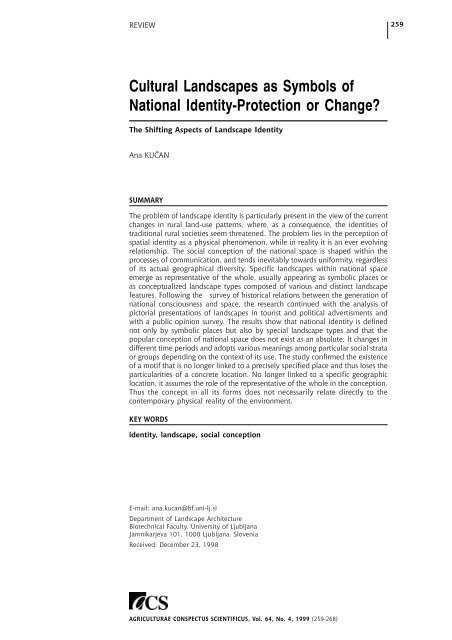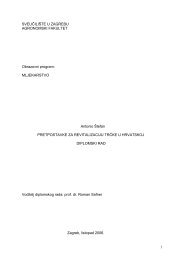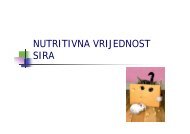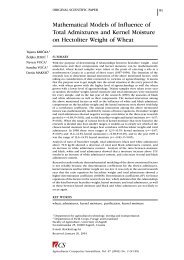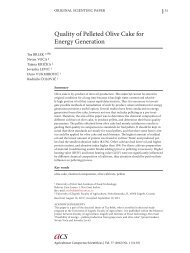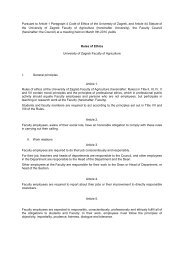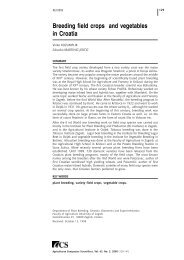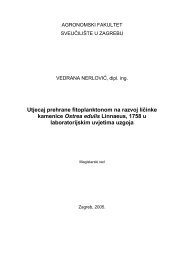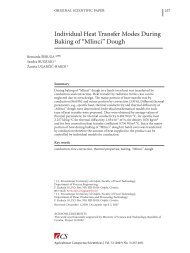Cultural Landscapes as Symbols of National Identity-Protection or ...
Cultural Landscapes as Symbols of National Identity-Protection or ...
Cultural Landscapes as Symbols of National Identity-Protection or ...
Create successful ePaper yourself
Turn your PDF publications into a flip-book with our unique Google optimized e-Paper software.
REVIEW 259<strong>Cultural</strong> <strong>Landscapes</strong> <strong>as</strong> <strong>Symbols</strong> <strong>of</strong><strong>National</strong> <strong>Identity</strong>-<strong>Protection</strong> <strong>or</strong> Change?The Shifting Aspects <strong>of</strong> Landscape <strong>Identity</strong>Ana KUÈANSUMMARYThe problem <strong>of</strong> landscape identity is particularly present in the view <strong>of</strong> the currentchanges in rural land-use patterns, where, <strong>as</strong> a consequence, the identities <strong>of</strong>traditional rural societies seem threatened. The problem lies in the perception <strong>of</strong>spatial identity <strong>as</strong> a physical phenomenon, while in reality it is an ever evolvingrelationship. The social conception <strong>of</strong> the national space is shaped within theprocesses <strong>of</strong> communication, and tends inevitably towards unif<strong>or</strong>mity, regardless<strong>of</strong> its actual geographical diversity. Specific landscapes within national spaceemerge <strong>as</strong> representative <strong>of</strong> the whole, usually appearing <strong>as</strong> symbolic places <strong>or</strong><strong>as</strong> conceptualized landscape types composed <strong>of</strong> various and distinct landscapefeatures. Following the survey <strong>of</strong> hist<strong>or</strong>ical relations between the generation <strong>of</strong>national consciousness and space, the research continued with the analysis <strong>of</strong>pict<strong>or</strong>ial presentations <strong>of</strong> landscapes in tourist and political advertisments andwith a public opinion survey. The results show that national identity is definednot only by symbolic places but also by special landscape types and that thepopular conception <strong>of</strong> national space does not exist <strong>as</strong> an absolute: It changes indifferent time periods and adopts various meanings among particular social strata<strong>or</strong> groups depending on the context <strong>of</strong> its use. The study confirmed the existence<strong>of</strong> a motif that is no longer linked to a precisely specified place and thus loses theparticularities <strong>of</strong> a concrete location. No longer linked to a specific geographiclocation, it <strong>as</strong>sumes the role <strong>of</strong> the representative <strong>of</strong> the whole in the conception.Thus the concept in all its f<strong>or</strong>ms does not necessarily relate directly to thecontemp<strong>or</strong>ary physical reality <strong>of</strong> the environment.KEY WORDSidentity, landscape, social conceptionE-mail: ana.kucan@bf.uni-lj.siDepartment <strong>of</strong> Landscape ArchitectureBiotechnical Faculty, University <strong>of</strong> LjubljanaJamnikarjeva 101, 1000 Ljubljana. SloveniaReceived: December 23, 1998AGRICULTURAE CONSPECTUS SCIENTIFICUS, Vol. 64, No. 4, 1999 (259-268)
CULTURAL LANDSCAPES AS SYMBOLS OF NATIONAL IDENTITY - PROTECTION OR CHANGE?263individual groups within the society relative to their social standing <strong>or</strong> thelocation <strong>of</strong> their residence, and whether there were differences <strong>as</strong> regardsthe intention <strong>of</strong> the conceptions, that is, differences between the spatialconception that is supposedly transmitted between generations, a kind <strong>of</strong>“fatherland education,” and the conception used to establish and maintainone’s self-image in relation to other people. The questions were combinedwith photographic representations <strong>of</strong> various Slovene landscapes.Given the subject <strong>of</strong> discussion, and in <strong>or</strong>der to achieve the greatest possiblevalidity, it made sense to carry out a public opinion survey on the b<strong>as</strong>is <strong>of</strong>a representative sample whose structure would reflect that <strong>of</strong> thepopulation. The representative sample w<strong>as</strong> determined by the Center f<strong>or</strong>the Research <strong>of</strong> Public Opinion and M<strong>as</strong>s Communications at the Faculty<strong>of</strong> Social Sciences, which also carried out the survey. In composing thesurvey, the attention w<strong>as</strong> primarily devoted to the problem <strong>of</strong> how to bestdescribe the landscape space <strong>of</strong> Slovenia without imposing our ownconceptions on those surveyed. Theref<strong>or</strong>e, the questionnaire retains thethree levels <strong>of</strong> landscape unit size cl<strong>as</strong>ses- place, motif, component—and<strong>as</strong>ks about them with both photographs and text. The space is describedby using carefully chosen spatial units that can act both <strong>as</strong> individual unitsand <strong>as</strong> general phenomena, depending on the context <strong>of</strong> conceptualization.The survey <strong>as</strong>ked about motif at two levels: about the characteristics <strong>or</strong>selected components <strong>of</strong> the space which in various combinations f<strong>or</strong>medlandscape patterns and about the landscape types <strong>or</strong> broader landscapepatterns with which we can describe the diversity <strong>of</strong> the Slovene space.In contr<strong>as</strong>t to the other two parts <strong>of</strong> the research, the survey, throughrecognizing the characteristics and significance <strong>of</strong> the landscape units thatbuild the conception <strong>of</strong> Slovenia in the perception and <strong>as</strong>sessment <strong>of</strong>individuals, w<strong>as</strong> aimed at discovering m<strong>or</strong>e intimate layers <strong>of</strong> the placeattachment<strong>of</strong> the population to the place they live.Illustration 2. The creation <strong>of</strong>pictograms f<strong>or</strong> the description <strong>of</strong>landscape motifs.ACS, Agric. conspec. sci. Vol. 64, No. 4, 1999
264Ana KUÈANRESULTSThe Changeability <strong>of</strong> the Conception-A Shifting <strong>Identity</strong>While the first part <strong>of</strong> the research w<strong>as</strong> rather inf<strong>or</strong>mative, both the secondand the third part questioned the existence <strong>of</strong> various conceptions <strong>of</strong> the sameconcept: they intended to discover whether differences exist in the conception<strong>of</strong> a Slovene space relative to its use. Following the research model aboutvarying conceptions <strong>of</strong> the same concept (Roth and Frisby 1986), it is alsopossible to conclude that within one social group in the same time periodthere are many perceptions <strong>of</strong> the same object, depending on its use. If it isthe perception that defines the identification (recognition) <strong>of</strong> space <strong>or</strong> theidentification <strong>of</strong> an individual <strong>or</strong> a certain community with the space theyinhabit, and the perception itself is also conditioned by the use (Canter 1977),then very probably there are differences in the meanings <strong>of</strong> individual parts<strong>of</strong> space, either in the places <strong>or</strong> in the landscape types and individualcomponents. The re<strong>as</strong>on probably lies in the use <strong>of</strong> the conception, that is inthe purpose the concept is activated f<strong>or</strong>. First is certainlyan individual’s personal<strong>as</strong>sessment one’s desire to convey a particular perception within a certaincommunity (m<strong>or</strong>e precisely, to transmit values between generations, that is,the “fatherland education”), that makes it possible to maintain the continuity<strong>as</strong>pect <strong>of</strong> group identity. Second is the communication <strong>of</strong> one’s self-image tothe outside w<strong>or</strong>ld (specifically, establishing one’s identity by comparison withother groups in other spaces - the differentiation <strong>as</strong>pect).Results from the analysis <strong>of</strong> the propaganda material proved that the conception<strong>of</strong> the space is relative to the time-dynamics: the analysis revealed time periods,which differ by the part <strong>of</strong> the territ<strong>or</strong>y included in a particular relatedconception, and by motifs, that is by specific aggregations <strong>of</strong> individuallandscape components that can be encountered in various spatial contexts,which define the periods in terms <strong>of</strong> contents. Some <strong>of</strong> these motifs are presentIllustration 3. Some mostfrequent motifs describingSlovene landscapesIllustration 4. Comparison between personal, “fatherland education”,and presentational conception.ACS, Agric. conspec. sci. Vol. 64, No. 4, 1999
CULTURAL LANDSCAPES AS SYMBOLS OF NATIONAL IDENTITY - PROTECTION OR CHANGE?265Illustration 5. Maps <strong>of</strong> Slovenia showing thedistribution <strong>of</strong> locations <strong>of</strong> the pict<strong>or</strong>ialrepresentations <strong>of</strong> landscapes included inadvertising material in different time periodsin all <strong>of</strong> the detected periods, and <strong>as</strong> such they act <strong>as</strong>connect<strong>or</strong>s providing continuity, while the others piledifferently in different periods. Some <strong>of</strong> the laterappear m<strong>or</strong>e <strong>of</strong>ten than the others, and only in specificcontexts <strong>of</strong> meaning. This is most expressive in thepict<strong>or</strong>ial language <strong>of</strong> political propaganda.The results clearly showed the differences in the sizecl<strong>as</strong>ses <strong>of</strong> landscape units: “the national” identifiesconceptually with entire regions and are<strong>as</strong>, <strong>as</strong> well <strong>as</strong>with concrete places <strong>or</strong> even with individual landscapefeatures, i.e. selected landscape components. Theconception binds all <strong>of</strong> them indiscriminately into somes<strong>or</strong>t <strong>of</strong> a spatial collage; theref<strong>or</strong>e, in the conception,even geographically distant landscape features canf<strong>or</strong>m one image, unrelated to size and position.The research confirmed, that some f<strong>or</strong>ms <strong>of</strong> theconception act <strong>as</strong> a prototype, a landscape motif(s)without clear connections to a certain place (<strong>or</strong>locality), thus creating the general landscape image <strong>of</strong>Slovenia. The social conception is, theref<strong>or</strong>e, also anideological construct: it seems independent <strong>of</strong> thechanges which ref<strong>or</strong>med landscapes in the course <strong>of</strong>hist<strong>or</strong>y; it neglects geographical diversities, and <strong>of</strong>tenbecomes an object <strong>of</strong> manipulation. Especially, whenparticular social groups use commonly acknowledgedsymbols to generalize its own system <strong>of</strong> values overthe entire nation.Despite some f<strong>or</strong>mal elements <strong>of</strong> continuity, the socialconception <strong>of</strong> space in Slovenia also demonstratessome shifts in meaning in different time periods. Recentpolitical propaganda pushes the conception back intothe frame <strong>of</strong> the era when the idea <strong>of</strong> national identityw<strong>as</strong> established in the 19th century. Today, however,the f<strong>or</strong>mal elements carry a different meaning: theydo no represent liberal progressive ide<strong>as</strong> <strong>as</strong> they did<strong>as</strong> the symbols <strong>of</strong> establishing national identity withinthe Austro-Hungarian empire, but a rather nostalgic,traditionalistic, even conservative point <strong>of</strong> view. In thecontinuity within the media image, the only exceptionis presented by the period following W<strong>or</strong>d War II, whenthe spirit <strong>of</strong> building a new society prevailed, and thespirit <strong>of</strong> technology and progress became evident inthe landscape conceptions, even on tourist posters.Then, industrialization w<strong>as</strong> an external sign thatYugoslavia - which at the time Slovenia w<strong>as</strong> a part -w<strong>as</strong> capable <strong>of</strong> overcoming economic backwardnessand guaranteeing progress. The healthy and idyllic ruralw<strong>or</strong>ld depicted by some popular painters w<strong>as</strong> then notsuitable f<strong>or</strong> the “<strong>of</strong>ficial” presentation <strong>of</strong> the country;furtherm<strong>or</strong>e, the spatial components, which denotedthe f<strong>or</strong>mer social <strong>or</strong>der, were disappearing. However,in parallel with the pict<strong>or</strong>ial material, through whichSlovenia presented itself in the framew<strong>or</strong>k <strong>of</strong> the thennew Yugoslavia (from 1945 on), the places whichremained were those that ideologically acceptablepositive fact<strong>or</strong>s and personalities linked to the nationalidentity and the struggle f<strong>or</strong> its existence. Although notalways against it, Slovenia did not entirely consent tothe “Yugoslav” concept: It still searched f<strong>or</strong> andACS, Agric. conspec. sci. Vol. 64, No. 4, 1999
266Ana KUÈANIllustrations 6.Pict<strong>or</strong>ial depictions <strong>of</strong>the current attitude <strong>of</strong>the conception <strong>of</strong>national space in threedifferent time periods:a)the painting Rodnagruda Native soil,by Maksim G<strong>as</strong>pari,a pre-W<strong>or</strong>ld War IIpostcard,b)a tourist “propaganda”from 1949: Turizem -izvrševalcem petletke.Tourism – to theexecut<strong>or</strong>s <strong>of</strong> theFive-Year Plan.c)election poster fromparliamentaryelections in 1992:Vrnili bomo slovenijidušo, srce in n<strong>as</strong>meh.We will give backthe soul, the heartand the smile toSlovenia.ACS, Agric. conspec. sci. Vol. 64, No. 4, 1999
CULTURAL LANDSCAPES AS SYMBOLS OF NATIONAL IDENTITY - PROTECTION OR CHANGE?267established its own identity within the multinationalstate. F<strong>or</strong> this purpose, the geographic characteristics<strong>of</strong> its territ<strong>or</strong>y <strong>of</strong>fered Slovenia numerous e<strong>as</strong>ilydiscernible identification components, and it looked f<strong>or</strong>others within its heritage. This heritage comprised therural idyll and the spatial components that guaranteedSlovenia’s existence.CONCLUSIONThe results, rendered by all the three parts <strong>of</strong> theinvestigation, including the results <strong>of</strong> the questionnaire,must theref<strong>or</strong>e be read in two ways:• AS PHENOMENA - characteristics, samples• AS EXPLANATION - circumstances, valuesIn the Slovene national conception, landscapes certainlyplay an imp<strong>or</strong>tant role <strong>as</strong> the carriers <strong>of</strong> identity. Theresults confirmed the <strong>or</strong>iginal hypotheses aboutlandscape components and patterns <strong>as</strong> the carriers <strong>of</strong>national spatial identity, <strong>as</strong> well <strong>as</strong> that the f<strong>or</strong>ming <strong>of</strong>a conception involves permanent interweaving <strong>of</strong> therelationship between physical and symbolic fact<strong>or</strong>s.The results from all three parts <strong>of</strong> the study haveindisputably confirmed the introduct<strong>or</strong>y hypothesis thatthe national identity is not only tied to the territ<strong>or</strong>ydefined by b<strong>or</strong>ders but to other spatial units <strong>as</strong> well. Itis not only a matter <strong>of</strong> being attached to places to whichspecial imp<strong>or</strong>tance is attributed in the system <strong>of</strong> socialvalues. The national identity is also tied to a certain socialconception <strong>of</strong> space, built from selected landscape typesand individual spatial components. The deliberatelychosen systematic cross-sections <strong>of</strong> the study show thechronological sequence <strong>of</strong> the f<strong>or</strong>mation <strong>of</strong> theconception and its verification in the conceptions <strong>of</strong> themodern public. Thus, it also discloses the mutual linkage<strong>of</strong> closed w<strong>or</strong>king units and their flowing into a whole.The results also showed that neither the landscape typesn<strong>or</strong> the individual landscape components in the sense<strong>of</strong> national identification are absolute categ<strong>or</strong>ies, butrather that their role within the social conception <strong>of</strong> thespace is changing. The continuity <strong>of</strong> the nation’sidentification with space is certainly b<strong>as</strong>ed primarily oncertain “sacred places <strong>of</strong> the nation.” Thus, speciallandscape types and motifs appear in the continuityconception which at the same time determinedifferentiation with respect to others. In the Slovenespace, it is primarily the mountain landscape type linkedto the cultural (agrarian) landscape that is most <strong>of</strong>tenreflected in the image <strong>of</strong> populated mountain valleys.The second element <strong>of</strong> the social conception <strong>of</strong> the spaceis the domestic landscape with its typical components:fields-meadows, vineyards, “kozolci,” and small churcheson elevations. The place most frequently chosen <strong>as</strong>representative is Bled, which combines the most typicalcharacteristics <strong>of</strong> both.Although we are aware <strong>of</strong> its diversity, once we crossthe reference threshold <strong>of</strong> “Slovene,” we refer toSlovenia <strong>as</strong> a homogenous territ<strong>or</strong>y from the landscapepoint <strong>of</strong> view. As we have seen, the landscape typerepresenting it is a kind <strong>of</strong> a spatial collage rather thana homogenous conception. There is an ideal conception,somewhat removed from reality, with which we Slovenes<strong>as</strong> a group identify ourselves. It is probably the question<strong>of</strong> a cultural mythos through which the exceptionality<strong>of</strong> the Slovene space is confirmed. This links us toourselves from the p<strong>as</strong>t (continuity), and at the sametime distinguishes us from others, even from those whoare similar (differentiation).This, <strong>of</strong> course, refers to the currently predominantconception. We have seen now one and then anothersignificance layer come to the f<strong>or</strong>e. In any c<strong>as</strong>e, there iscertainly a gap between principles and practice: 50%<strong>of</strong> the population still lives in a predominantly ruralspace but only 6% lives from it. In this sense the“newcomers” are transf<strong>or</strong>ming rural landscapes into <strong>as</strong>pace that is attractive f<strong>or</strong> living in acc<strong>or</strong>dance with theirsomewhat idealized view <strong>of</strong> the countryside. The newcommunication technologies <strong>of</strong>fer almost everyone theadvantages that the modern way <strong>of</strong> life and w<strong>or</strong>kdemands, thus enabling a very high quality <strong>of</strong> life inrural environments. In this way, the rural landscapes inSlovenia are being slowly transf<strong>or</strong>med into a “modernArcadia” (Marušiè 1995), tending toward a unif<strong>or</strong>menvironment in the physical and cultural sense. This is,however, precisely that the <strong>or</strong>igin <strong>of</strong> many spatialconflicts.The ideal conception is undoubtedly also the result <strong>of</strong>the picture conveyed by the media and other ideologicalapparatuses, reflecting and simultaneously impacting thevalue system. While, within the value system, there aredifferences between the principle values and those bywhich we <strong>or</strong>ient ourselves in practice <strong>as</strong> individuals <strong>or</strong><strong>as</strong> a society, the manipulation <strong>of</strong> the spatial identity,which occurs on the national level, can be counterproductive.Creating an unrealistic image <strong>of</strong> space andbecoming infatuated with it can blur the vision and blindus to serious problems in the environment. Theref<strong>or</strong>e,it makes no sense to limit the spatial identity only tothe components established <strong>as</strong> national symbols duringthe periods <strong>of</strong> endeav<strong>or</strong>s f<strong>or</strong> nationhood. The knowledgeabout the processes <strong>of</strong> establishing the social conception<strong>of</strong> space, provided by the present study, is certainlyuseful inf<strong>or</strong>mation. But only further studies will be ableto provide m<strong>or</strong>e precise answers to the questionswhether the development will indeed mean a loss <strong>of</strong>identity <strong>or</strong> will it bring qualitative change. Thecountryside - and not only in Slovenia - stands on thethreshold <strong>of</strong> maj<strong>or</strong> changes, <strong>as</strong> much in the sense <strong>of</strong>social <strong>as</strong> <strong>of</strong> spatial restructuring: the laws <strong>of</strong> the Europeanand w<strong>or</strong>ld markets have already brought much f<strong>as</strong>terchanges than those we witnessed in the not so distantp<strong>as</strong>t. Assuming that the need f<strong>or</strong> the preservation <strong>of</strong> thepatterns <strong>of</strong> land-use is demonstrated, even if onlybecause <strong>of</strong> the principle <strong>of</strong> protecting our cultural andnatural heritage, it will not be possible withoutsubstantial financial supp<strong>or</strong>t from the state. Here it isACS, Agric. conspec. sci. Vol. 64, No. 4, 1999
268Ana KUÈANvery imp<strong>or</strong>tant to know the socially established valuesystem - the system <strong>of</strong> principle definitions, whichsociety f<strong>or</strong>ms in relation to the space in which it livesand their disharmony with the prevailing behavi<strong>or</strong>.In spite <strong>of</strong> the universal models f<strong>or</strong> managing thephysical environment, it could be possible to preservethe spatial identity in this respect <strong>as</strong> well. One <strong>of</strong> thehindering fact<strong>or</strong>s in Slovenia is certainly the physicalspace; other fact<strong>or</strong>s undoubtedly include culturaldifferences b<strong>as</strong>ed on hist<strong>or</strong>ical mem<strong>or</strong>y. Neither the realspace n<strong>or</strong> the social conception <strong>of</strong> it are constant butdepend upon the times—they emerge and complementeach other in the course <strong>of</strong> constant change. From thiswe can conclude that any f<strong>or</strong>m <strong>of</strong> inclusion in the w<strong>or</strong>ldintegration processes will not mean a loss <strong>of</strong> identitybut rather its qualitative change only.REFERENCESBRAUDEL, F. (1988) The <strong>Identity</strong> <strong>of</strong> France. Hist<strong>or</strong>y andEnvironment. Collins, London.symbolic landscapes, Wageningen, Netherlands,September 1994. Unpublished version, 18 p.CANTER, D. (1977) The Psychology <strong>of</strong> Place. TheArchitectural Press, London.COSGROVE D., DANIELS S., Ed. (1988) The Iconography<strong>of</strong> Landscape. Cambridge University Press, Cambridge.DANIELS S. (1993) Fields <strong>of</strong> Vision: Landscape Imageryand <strong>National</strong> <strong>Identity</strong> in England and the UnitedStates. Princeton University Press, Princeton.KUÈAN A. (1996) Dejavniki nacionalne prost<strong>or</strong>skeidentitete na Slovenskem. (Aspects <strong>of</strong> SpatialPerception in Relation to <strong>National</strong> Idetity.) Doct<strong>or</strong>alThesis. Department <strong>of</strong> Landscape Architecture,Biotechnical Faculty, University <strong>of</strong> Ljubljana, Ljubljana.KUÈAN A. (1997) Modern Social Conception <strong>of</strong> SloveneSpace. (Slovenski prost<strong>or</strong> v sodobni družbenipredstavi.) In: Acta Geografica 37 (1997): 111-169.Scientific Research Centre <strong>of</strong> the Slovenian Academy<strong>of</strong> Sciences and Arts, Geographical Institute, Ljubljana.LENZ-ROMEISS F. (1970) Die Stadt – Heimat oderDurchgangstation? Calwey Verlag, Muenchen.LOWENTHAL D. (1994) Landscape <strong>as</strong> Living Legacy. In:International symposium on Symbolic <strong>Landscapes</strong>,Wageningen. Unpublished version.MARUŠIÈ J. (1995): Razpotja urejanja in varstvaSlovenske krajine. (Crossroads <strong>of</strong> Planning andConservation <strong>of</strong> Slovenian Landscape.) In: Veselaznanost O okolju. (Merry Science. On Environment.)KUD France Prešeren, Ljubljana.ROTH I., FRISBY J. (1986) Perception and Representation:A Cognitive Approach. Open University Press,Philadelphia.SMITH A. D. (1991) <strong>National</strong> <strong>Identity</strong>. University <strong>of</strong>Nevada Press.VODOPIVEC P. (1996) Pogov<strong>or</strong> (Conversation). In:Crnkoviè M. Ed. Slovenska smer (the Direction <strong>of</strong>Slovenia). Cankarjeva založba, Ljubljana.ACS, Agric. conspec. sci. Vol. 64, No. 4, 1999


